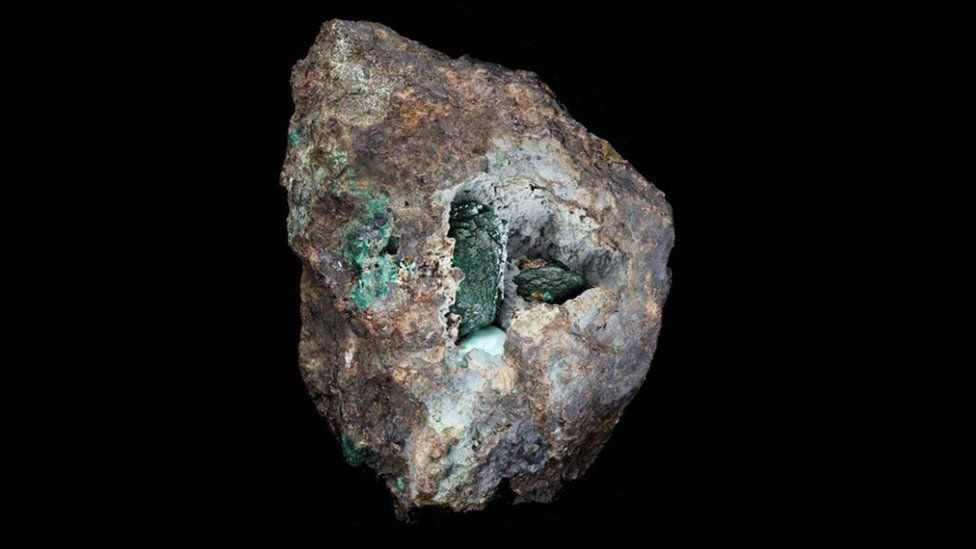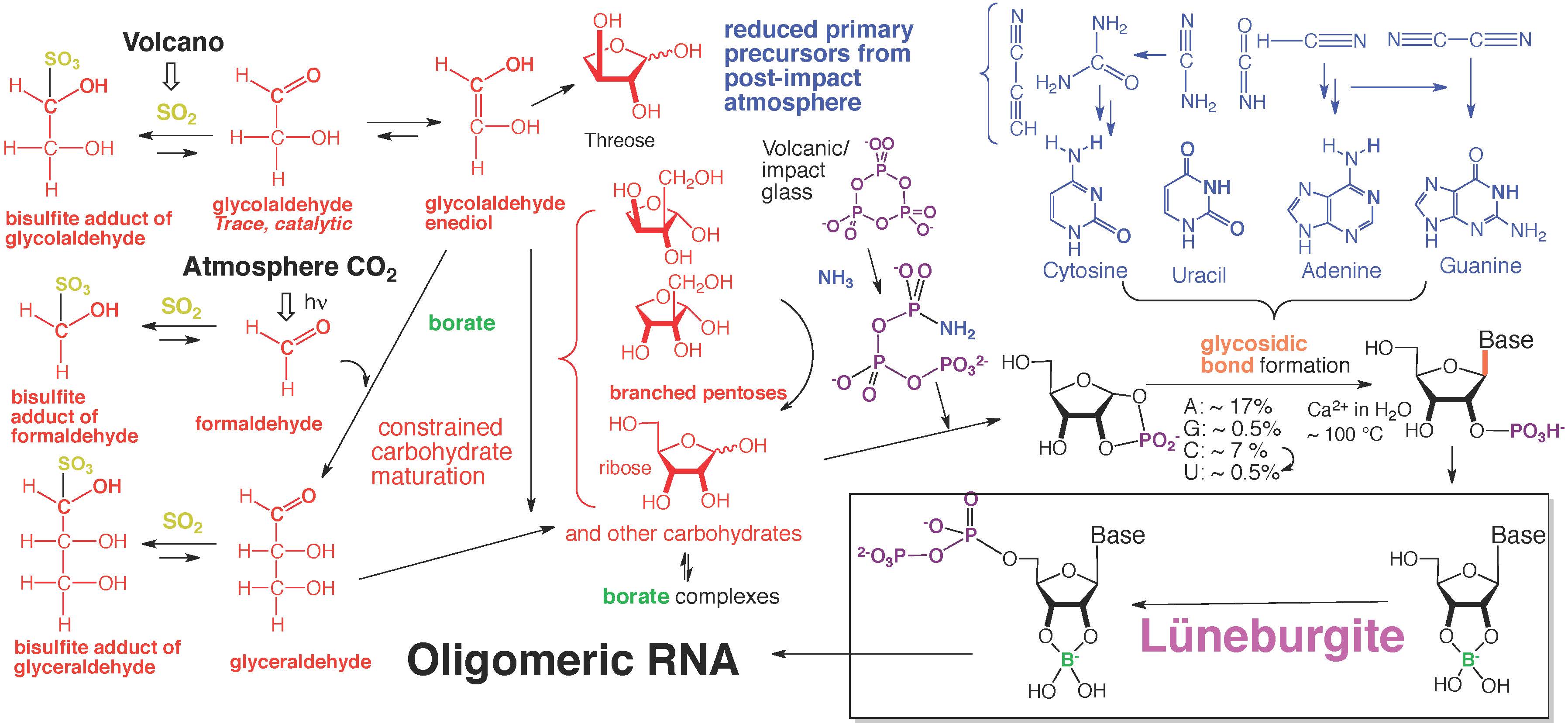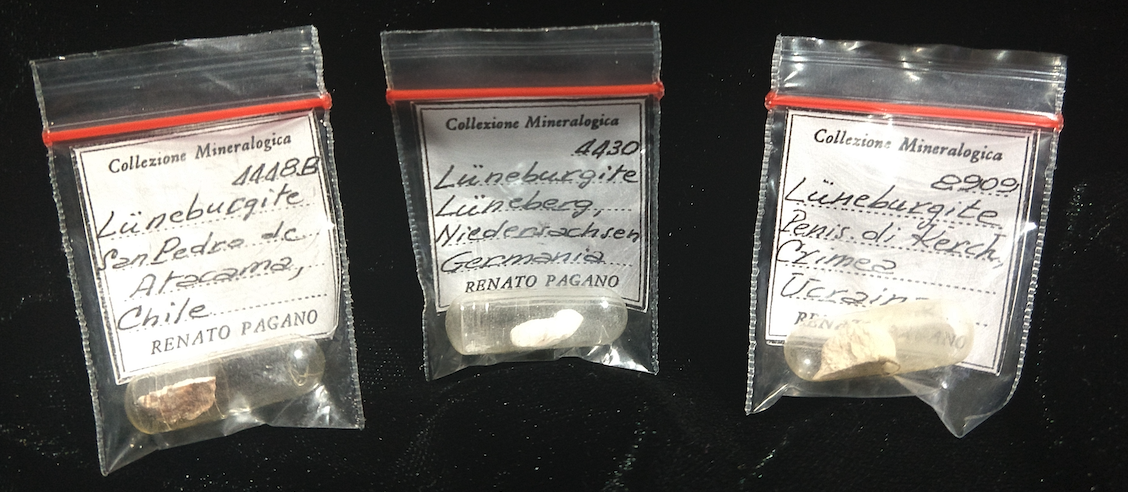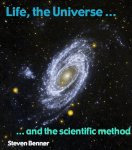
Ernest Rutherford is often cited as saying that science consists only of “physics and stamp collecting.” Geology collects minerals, biology collects species, and chemistry collects molecules. But only physics, in his view, generates mathematically formulated theories that have predictive and explanatory powers.
A great quote, although it is a bit demeaning to us chemists.
Just before Christmas last month, a team of stamp collectors (who call themselves geologists) from the Natural History Museum in London was puttering around Cornwall. They came across a new mineral. As its discoverer, Mike Rumsey and his team got to name it. Kernowite, since “Kernow” is how the Cornish language refer to Cornwall. Linguistics is another stamp collecting field.
Minerals are defined as naturally occurring assemblages of atoms. Kernowite is Cu2Fe(AsO4)(OH)4·4H2O. The new mineral “stamp” is made from atoms of copper, iron, arsenic, oxygen, and hydrogen.
The fact that this material is found in the wilds of Cornwall, not just in a lab, means that it can form naturally. It also means that in a chemically complex environment, just as the Earth itself, these elements can sort themselves out from many other possible arrangements, without human intervention.
This is scientifically useful stamp collecting. The discovery of this mineral does not create any scientific paradoxes. It does not force us to revise our understanding of these elements, or chemistry in general. But it does say that some collections of atoms can exist naturally, without human intervention. It is, if I am allowed, an “observational experiment”. Therefore, this discovery is more than just a pretty emerald green postage stamp from the natural world.
Observations that atoms can arrange themselves in certain ways without human intervention is very important for those hoping to understand how life originated. For example, phosphorus is important for life. It is found abundantly on Earth in the form of phosphate, one phosphorus atom combined with four oxygen atoms. A natural arrangement in the Hadean environment.
The same arrangement of oxygen and phosphorus atoms is found in RNA. RNA is thought to be the first genetic molecule to support Darwinian evolution on Earth. If phosphate (PO4) occurs naturally, without human intervention, can we say that this part of the puzzle for how RNA arose on Earth without human intervention is … well … in hand?
But phosphate has a problem. In the presence of calcium, phosphate precipitates as calcium phosphate, the mineral called apatite. Now, “apatite” is not named because it has something to do with diet; linguist “stamp collectors” cite the Greek word meaning “deceive” for its origins. That word was chosen by German mineralogists because apatite comes in many different colors and forms, and can therefore be confused with other minerals.
Because of the low solubility of calcium phosphate, the phosphate in apatite is not easily available to prebiotic chemistry. Sure, human manipulation in the lab can extract phosphate from apatite. This is how we make fertilizer in Central Florida; humans dump sulfuric acid on apatite. But on the prebiotic Earth, there were no humans to do the dumping. Here is where geological stamp collecting becomes important.
In the lab, even though calcium and phosphate (when mixed) precipitate as apatite, if the beaker also contains magnesium, sulfate, and borate, something else happens. Instead of being lost as insoluble calcium phosphate, the phosphate is captured by magnesium and borate. The captured product is the mineral “stamp” called lüneburgite, which is magnesium borophosphate. The left-over calcium combines with sulfate to form calcium sulfate (with a water molecule), the mineral gypsum.
Why is this important? Because lüneburgite reacts with RNA building blocks, called ribonucleosides, and transfers its phosphate to them. At the same time, the borate from lüneburgite holds the ribose of the ribonucleoside, making sure that the phosphate goes to the correct position. The product ribonucleotide (change an “s” to a “t”) is a precursor for RNA.
Thus, lüneburgite supports one step in the “prebiotic” formation of RNA. It is the step in the box in the scheme just below.
This is all good in the lab. But what about on a prebiotic Earth? Could lüneburgite have kept calcium away from phosphate in the prebiotic wilderness, without human intervention?
Here, stamp collecting is very, very important. Many geologist “stamp collectors” have looked around, in Cornwall and many other places on Earth. And they have found many natural deposits of lüneburgite together with gypsum.
So the answer is “yes”. Even without human intervention, magnesium, phosphate, borate, calcium, and sulfate combine to prevent phosphate from being lost to apatite. Instead, the phosphate ends up being converted to a mineral that can help in a step to form RNA.
And on Mars? NASA exploration has found calcium, magnesium, phosphate, borate, and sulfate together. We expect to find these arranged as lüneburgite and gypsum. If so, they are available today to make ribonucleotides on Mars, if ribonucleotides were to be available.
Hooray for stamp collecting.
A year or two back, I mentioned this to Rob Lavinsky, who sells fine mineral “stamps” to the public. See his website. Rob trained as a molecular biologist, and got very excited. He found some samples of lüneburgite, shown here. One of them is even a “type” specimen, coming from … Lüneburg. Which is what linguists tell us that Germans call the town of … Lüneburg.



